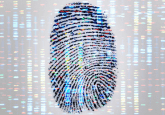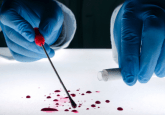Crime-solving: it’s in the genes

The use of genetic material in forensic science has progressed significantly since its implementation little over 30 years ago. Now, scientists believe that not only can genes provide information to link a person to a crime scene but they can also provide clues to determine time of death.
The use of genetics in forensic science began in 1984, when 34-year-old Alec Jeffreys produced the first DNA fingerprint from his laboratory at the University of Leicester (UK).
“In science it is unusual to have such a ‘eureka’ moment. We were getting extraordinarily variable patterns of DNA, including from our technician and her mother and father, as well as from non-human samples. My first reaction to the results was ‘this is too complicated’, and then the penny dropped and I realized we had genetic fingerprinting,” explained Jeffreys. (1)
The genetic fingerprinting ‘Eureka!’ moment
This first technique (2) used radio-labeled DNA probes containing minisatellites that were hybridized to DNA that had been digested with a restriction enzyme. The restriction enzyme targets specific sites in the DNA that have varied positions in different individuals, leading to differing sizes of DNA fragments.
The fragments were then separated by electrophoresis and immobilized on a membrane by Southern blotting. After washing away the excess probe, exposure to X-ray film allows the variable fragments to be visualized and their profiles compared between individuals. It is possible to detect around 15 to 20 variable fragments per individual, which range from 3.5 to 20kb in size. Differences in these length-based measurements between individuals can be used to identify potential suspects.

An example of genetic profiling, showing how variable DNA fragments have moved down a gel, corresponding to their size.
The first application of genetic fingerprinting came with the case of the rape and murder of two young girls in Leicestershire (UK). A man had been arrested who admitted to one murder but not the other. The police used genetic profiling in the hope to prove him guilty of both murders, but found he was not guilty of either.
Over 5000 DNA samples were taken from men in the area and tested to no avail. However, it was discovered that Colin Pitchfork had evaded giving a sample, instead persuading his friend to do it for him. In 1987, Pitchfork would become the first person to be convicted based on DNA evidence after his DNA profile was matched to samples from the crime scene.
“I felt relief because he was a serial murderer and would kill again, and because if the operation had failed then the public’s perception of forensic DNA would have been shattered,” commented Jeffreys.
For the following 2 years, the Jeffreys’ laboratory at the Lister Institute of Leicester would be the only place to utilize DNA fingerprinting. Companies, academic institutions, police and law enforcement offices around the world then began developing and improving upon their own versions of the tool.
As methods have been greatly improved over time, the original fingerprinting technique is no longer used in forensic science. Changes were made to simplify and automate the technique, including swapping the Southern blot for PCR, the use of fluorescent labels instead of radioactive ones and capillary electrophoresis instead of slab gels.
Genetic fingerprinting on trial
The haste for DNA fingerprinting to be accepted worldwide as a forensic tool caused standards to slide and certain necessary protocols were often overlooked.
In 1989 a judge ruled for the first time that genetic tests, which linked a murder suspect to a victim, were not scientifically reliable (3).
In the People vs Castro case in New York (NY, USA), it was said that samples were flawed and as a result, they were inaccurate. Since then, researchers have worked on improving the quality of methods so mistakes cannot be made; however, results still cannot be 100% accurate.
Many experts are now convinced that the future of genetics in forensic science lies in genome sequencing as opposed to the current methods based on fragment length analysis. The emergence of next-generation sequencing (NGS) could lead to a more rapid and cost-effective analysis (4).
However, these methods are not without their flaws either. Increasing accuracy and sensitivity makes usable DNA more likely to be detectable than before. In balance to this, contamination DNA will also be more likely to be detectable. Responsibility will fall to the scientists to determine if the presence of a few cells at a crime scene can be correlated with the crime.
Improvements in probability software over recent years have also created more uncertainty, making evidence much less reliable.
Next-generation forensic genetics
Current forensic DNA profiles consist of size measurements of variable fragments. The NGS tests will allow the sequencing of these fragments, potentially resulting in increased ability to differentiate between individuals. The sequencing of alternative marker types can also result in phenotype prediction in unsolved cases (5).
Our genomes already provide evidence to match perpetrators to a crime scene and the potential of NGS in forensic genetics could enable investigators to build up a picture of a criminal based on the information from their genome.
A study, published in Nature Communications, by a team at the Centre for Genomic Regulation (Barcelona, Spain) suggests our genes could hold the key to time of death (TOD), too (6).
Currently, medical examiners determine time of death using dropping body temperature, extent of rigor mortis and number of insects around the body.
“Our goal was to show that the patterns of gene expression carry information on the time that has lapsed since death, and that this information could eventually be used in forensic pathology,” explains study leader, Roderic Guigo.
The team analyzed gene activity and degradation in 36 different kinds of human tissue, such as the brain, skin and lungs. Tissue samples were collected from more than 500 donors who had been dead for up to 29 hours.
Guigo continued, “The expression of genes changes after the death of the organism in a quite tissue-specific fashion. Some tissues respond very rapidly to the organism death, with many genes changing expression almost immediately after death in muscle, while in other tissues most gene expression changes occur sometime after death.”
The researchers used a computer to search for patterns in this activity and found that just four tissues taken together could give a reliable TOD: subcutaneous fat, lung, thyroid and skin exposed to the sun. The team then developed an algorithm that a medical examiner might one day use to determine TOD. When tested, the algorithm worked to within 9 minutes of actual TOD.
It is hoped that the future of determining TOD could be in the combination of this information gathered from genetic activity alongside microbial changes.





